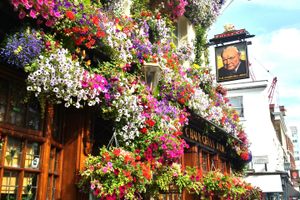About
If there is one novel associated with Kensington Gardens, it would most likely be J. M. Barrie's 1911 blockbuster Peter Pan and Wendy. What many people might not know, however, is that the character of Peter Pan was a literary creation for adults before he became "the boy who wouldn't grow up." In 1906, the mischievous entity was featured in a book entitled Peter Pan and Kensington Gardens. This tome was comprised of a collection of short stories involving the adventures of our titular hero, taking place in the surrounding environs.
One such episode is a rather somber and macabre tale, involving two children who were lost or became abandoned, once the park's gates had closed for the evening.
The following is an excerpt from the novel: "Pan comes round. He has been too late several times, and when he sees he is too late he runs back to the Thrush’s Nest for his paddle, of which Maimie had told him the true use, and he digs a grave for the child and erects a little tombstone, and carves the poor thing’s initials on it. He does this at once because he thinks it is what real boys would do, and you must have noticed the little stones, and that there are always two together. He puts them in twos because they seem less lonely. I think that quite the most touching sight in the Gardens is the two tombstones of Walter Stephen Matthews and Phoebe Phelps. They stand together at the spot where the parish of Westminster St. Mary’s is said to meet the Parish of Paddington. Here Peter found the two babes, who had fallen unnoticed from their perambulators, Phoebe aged thirteen months and Walter probably still younger, for Peter seems to have felt a delicacy about putting any age on his stone. They lie side by side, and the simple inscriptions read: W.St. M. 13a. and P.P. 1841."
Just as the story relates, these tombstones are indeed boundary markers. Surveying stones that indicate the parishes of Westminster, (W.St. M. 13a.) and Paddington,(P.P. 1841). Barrie, who was a resident of the area, incorporated his knowledge of the landscape into weaving a fictional tale around the purpose of these demarcations, by attributing the carved initials as the names of two tragic souls. Thus giving us modern visitors a chilling thought as we wander around this luscious green space, keeping an ever-watchful eye on our wards and the time.
Related Tags
Know Before You Go
Depending on the season, the garden's hours vary. Check the website to avoid disappointment.
The stones are off Kensington Gardens Broad Walk, between the Queensway tube entrance and the Queen Victoria statue.
At ground level on the left-hand side of the Broad Walk, whilst walking towards Kensington Palace from Queensway, there is a low marker stone marking the centre of the boundary of Paddington.
There are two stones on the right just before Kensington Palace. The Peter Pan ones are the same distance away on the left, at the base of the tree directly left from the marker.
The stones are visible at a distance from the path, to access them close up requires crossing the grass.
Queensway, on the Central Line, is the nearest underground station.
Community Contributors
Added By
Published
July 14, 2023

















































